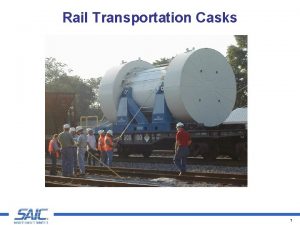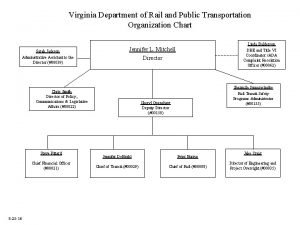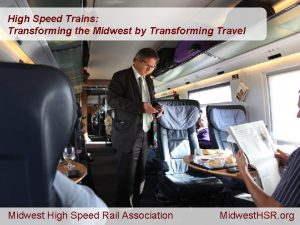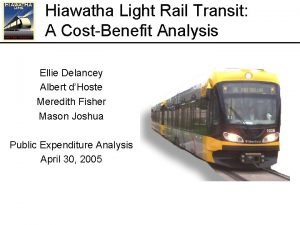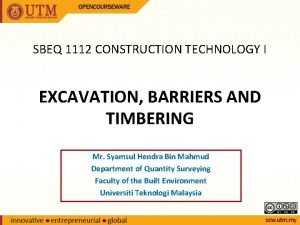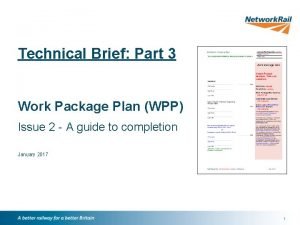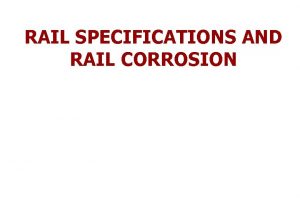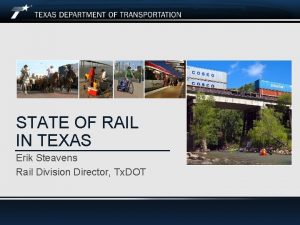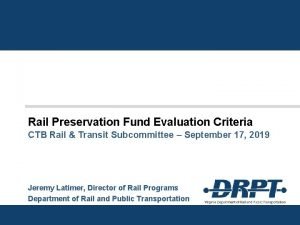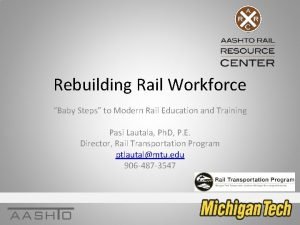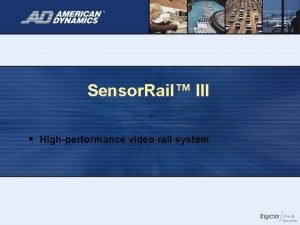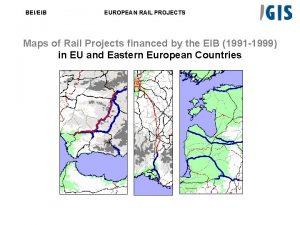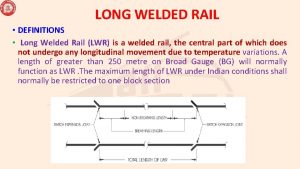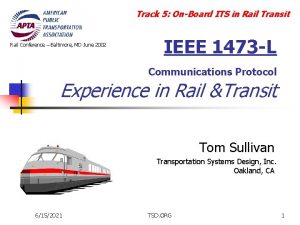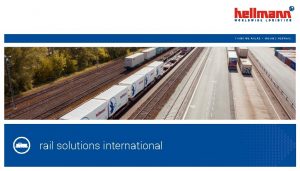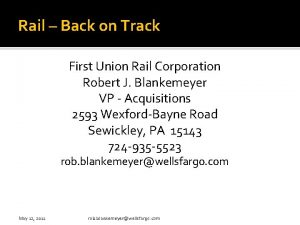Rail Transportation Casks 1 Testing of Transportation Casks

























- Slides: 25

Rail Transportation Casks 1

Testing of Transportation Casks · To be certified, transportation casks must demonstrate that they must remain airtight following – A 30 -foot drop onto an unyielding surface – A 40 -inch drop onto a 6 -inch diameter steel rod – Exposure to a 1000 ºC fire for 30 minutes – Immersion in 3 feet of water · Additional, more severe, testing has been done – Crash of a flatbed truck loaded with a cask into a 700 -ton concrete wall at 80 mph – Broadside crash of a 120 -ton locomotive traveling at 80 mph – Crash of a locomotive at 100 mph (U. K. ) – Drop onto hard soil (similar to concrete) from a height of 2, 000 feet – Fire and explosion involving fuel tanks (Germany) 2

Fire and Explosion Testing 3

Repository Design Concept 4

Yucca Mountain Surface Facility Portals South Portal North Portal 5

Surface (Preclosure) Facility Design · Surface facility design provides maximum flexibility in the development of a simple, clean, safe, primarily canisterbased repository – Based on the use of modular waste handling facilities and processes – expansion as needed – Incorporates commercial waste handling experience – Can receive by truck and standard rail – Can handle multiple forms of wastes – Can accommodate multiple sizes of transportation, aging and disposal (TAD) canisters w TAD canisters containing the spent fuel are loaded into the transportation casks w TAD canisters would require less handling than individual spent nuclear fuel assemblies at the repository 6

Aboveground Preclosure Facilities 7

Preparing Waste for Emplacement · Cask enters the facility, impact limiters and lid are removed, and the cask is raised upright by crane · Cask loaded onto a cask transfer trolley and moved to the shielded transfer cell · Another crane lifts the TAD canister out and raises it into a shielded bell · Shielded bell moves to the canister to another transfer cell · Canister is lowered by crane into the waste package – Waste package is what the canister is stored in when emplaced in the mountain · Waste package is transferred to the Transport and Emplacement Vehicle (TEV) 8

Transfer of Canister to Waste Package casktransfer. wmv 9

Transfer of the Waste Package to the TEV WPtransferto. TEV. wmv 10

Emplacement Operations · TEV moves waste package from the surface facility into the mountain – Emplacement tunnel is selected beforehand to limit the total decay heat generated in the tunnel – Tunnel decay heat loading is tracked continuously · TEV deposits the waste package once it has arrived at its final destination · TEV returns to the surface 11

Emplacement Operations 12

Safety of Preclosure Operations · Preclosure operations include all preparation and emplacement activities – Expected to last 50 years (until all tunnels are filled) · Safety features – Robust construction (3 to 4 -foot thick reinforced concrete walls) can withstand the most severe postulated earthquake – Filtered ventilation system to prevent release to environment in the event of an accident – Automatic fire suppression system – Remote operations to limit need for human action – Extensive shielding provided when human involvement is anticipated · Safety analyses show that potential public and worker radiation exposure from preclosure operations is well below NRC safety limits 13

Postclosure · Postclosure begins when the repository has been fully loaded and sealed for long-term storage · Storage is in 42 -miles of 18 -foot diameter tunnels · Parallel tunnels located 250 feet apart · Tunnels are 1, 000 feet below the surface and 1, 000 feet above the water table · Natural and manmade features ensure safety and environmental protection during storage 14

Underground Storage of Waste 15

Natural and Manmade Safety Features 16

Total System Performance Assessment · TSPA is a computer tool that analyzes performance of the repository following closure · Includes computer models for all phenomena that could lead to a release of radionuclides – Based on accepted chemical and physical principles – Benchmarked against data collected during site assessment · TSPA is used to evaluate repository performance over hundreds of thousands of years · Because the period of interest is so long, extremely rare events must be analyzed – Severe earthquakes, volcanic activity, meteor strikes, etc. · TSPA results show human exposures or ground water contamination at least a factor of 10 smaller than safety standards 17

Concept for a Warning Monument and Information Center 18

Status and Future of the Project · License application for the Yucca Mountain repository submitted to the NRC on June 2 nd · NRC has 3 years to complete their evaluation and decide whether to issue a construction permit · Government funding levels will be an important factor in determining when the repository opens – Most optimistic estimate is 2017 for receipt of first waste · Politics will play a key role 19

Politics of the Yucca Mountain Project · NIMBY – Not in my backyard – States with stored nuclear waste want it disposed of – Nevada objects to being the nuclear “dump” – Some have concerns over waste transport · People are reluctant to believe the government regardless of the scientific support · Politicians tend to play on these emotions – Nowhere is this more evident than in Nevada – A “battleground” state 20

Cartoons Illustrating Political and Legal Obstacles 21

Cartoons Illustrating Safety Concerns Cartoonists play on emotions • No need to be scientifically accurate • Probably very effective with the average person 22

Where do the candidates stand? · Obama expressed his opinion in a letter to Senators Reid and Boxer – Nuclear power remains an important source of energy – Objected to Congress abandoning scientific consideration of alternatives and selecting Yucca Mountain – Indicated that Yucca Mountain is not a good choice w Nevadans oppose Yucca Mountain w Won’t be operated for at least 10 more years w Uncertain safety of transport and long-term storage – Time to abandon Yucca Mountain and pursue alternatives w Selection based on sound science and respect for state’s sovereignty 23

Where do the candidates stand? · Mc. Cain’s opinion has been expressed in interviews over the years – Nuclear power is an important source of energy for our future and more reactors are needed – Supports Yucca Mountain as the best alternative for long-term storage – Yucca Mountain should be built if it meets all Federal requirements for protecting human health and the environment – Not a problem of technology but political will 24

Questions? 25
 Transportation casks
Transportation casks Virginia department of rail and public transportation
Virginia department of rail and public transportation Advantages and disadvantages of transportation
Advantages and disadvantages of transportation Neighborhood integration testing
Neighborhood integration testing Decision table testing examples
Decision table testing examples Positive negative testing
Positive negative testing Testing blindness in software testing
Testing blindness in software testing Language testing
Language testing Domain test means
Domain test means Black-box testing disebut juga sebagai behavioral testing
Black-box testing disebut juga sebagai behavioral testing Blackbox testing
Blackbox testing Cs3250
Cs3250 Component testing is a black box testing
Component testing is a black box testing Control structure testing in software engineering
Control structure testing in software engineering Motivational overview of logic based testing
Motivational overview of logic based testing Table based testing
Table based testing Globalization testing in software testing
Globalization testing in software testing Types of domain testing
Types of domain testing Decision table testing in software testing
Decision table testing in software testing Du path testing
Du path testing Rigorous testing in software testing
Rigorous testing in software testing Midwest high speed rail association
Midwest high speed rail association Hiawatha light rail
Hiawatha light rail Continuous tubular rails
Continuous tubular rails Work package plan template
Work package plan template Red rail tours
Red rail tours
